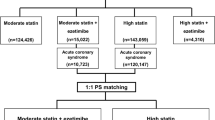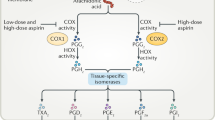Abstract
The elderly represent a notable proportion of patients who present with myocardial infarction or acute coronary syndromes. This subgroup of patients also experiences a higher incidence of adverse outcomes than younger age-groups, and, therefore, has more to gain from effective, evidence-based therapies. The efficacy of statins in secondary cardiovascular disease prevention is firmly established. The starting of therapy soon after an acute coronary event has been shown to provide added benefit. Uncertainties about the effectiveness of statins in the elderly, however, have resulted in their underuse in this population. In this review we evaluate the evidence for statin use in this important and increasingly large group of patients.
Key Points
-
The efficacy and safety of 3-hydroxy-3- methylglutaryl coenzyme A reductase inhibitors (statins) have been established for primary and secondary cardiovascular disease prevention
-
The elderly have much to gain from statin therapy but these drugs are consistently underprescribed, partly because of under-representation of elderly patients in clinical trials
-
Risk: benefit ratios and cost-effectiveness data clearly support the widespread use of statins for secondary cardiovascular prevention in elderly patients
-
Data are limited on aggressive statin therapy after acute coronary syndromes in elderly people, but evidence suggests that an LDL-cholesterol target of <1.8 mmol/l (70 mg/dl) is reasonable
This is a preview of subscription content, access via your institution
Access options
Subscribe to this journal
Receive 12 print issues and online access
$209.00 per year
only $17.42 per issue
Buy this article
- Purchase on Springer Link
- Instant access to full article PDF
Prices may be subject to local taxes which are calculated during checkout


Similar content being viewed by others
References
Schwartz JB et al. (2005) Cardiovascular disease in the elderly. In Heart Disease: a Textbook of Cardiovascular Medicine, edn 7, 1925–1949 (Eds Braunwald E et al.) Philadelphia: WB Saunders
Mehta RH et al. (2001) Acute myocardial infarction in the elderly: differences by age. J Am Coll Cardiol 38: 736–741
Rich MW et al. (2003) Executive summary: second Pivotal Research in Cardiovascular syndromes in the Elderly (PRICE-2) symposium. Acute coronary syndromes in the elderly: mechanisms and management. Am J Geriatr Cardiol 12: 307–327
Rathore SS et al. (2003) Effects of age on the quality of care provided to older patients with acute myocardial infarction. Am J Med 114: 307–315
Alexander KP et al. (2005) Evolution in cardiovascular care for elderly patients with non-ST-segment elevation acute coronary syndromes: results from the CRUSADE National Quality Improvement Initiative. J Am Coll Cardiol 46: 1479–1487
Krumholz HM et al. (1996) Aspirin for secondary prevention after acute myocardial infarction in the elderly: prescribed use and outcomes. Ann Intern Med 124: 292–298
Ko DT et al. (2004) Lipid-lowering therapy with statins in high-risk elderly patients: the treatment-risk paradox. JAMA 291: 1864–1870
Fonarow GC et al. (2001) In-hospital initiation of lipid-lowering therapy for patients with coronary heart disease: the time is now. Circulation 103: 2768–2770
Gurwitz JH et al. (1992) The exclusion of the elderly and women from clinical trials in acute myocardial infarction. JAMA 268: 1417–1422
Alter DA et al. (2004) Age, risk-benefit trade-offs, and the projected effects of evidence-based therapies. Am J Med 116: 540–545
Hirth VA (2005) Aronow's “Should the NCEP III guidelines be changed in elderly and younger persons at high risk for cardiovascular events?” Hyperlipidemia in seniors: too much, too little, too late? J Gerontol A Biol Sci Med Sci 60: 595–597
The Scandinavian Simvastatin Survival Study Group (1994) Randomised trial of cholesterol lowering in 4444 patients with coronary heart disease: the Scandinavian Simvastatin Survival Study (4S). Lancet 344: 1383–1389
Sacks FM et al. (1996) The effect of pravastatin on coronary events after myocardial infarction in patients with average cholesterol levels. N Engl J Med 335: 1001–1009
The Long-Term Intervention with Pravastatin in Ischaemic Disease (LIPID) Study Group (1998) Prevention of cardiovascular events and death with pravastatin in patients with coronary heart disease and a broad range of initial cholesterol levels. N Engl J Med 339: 1349–1357
Miettinen TA et al. (1997) Cholesterol-lowering therapy in women and elderly patients with myocardial infarction or angina pectoris: findings from the Scandinavian Simvastatin Survival Study (4S). Circulation 96: 4211–4218
Lewis SJ et al. (1998) Effect of pravastatin on cardiovascular events in older patients with myocardial infarction and cholesterol levels in the average range: results of the Cholesterol and Recurrent Events (CARE) trial. Ann Intern Med 129: 681–689
Hunt D et al. (2001) Benefits of pravastatin on cardiovascular events and mortality in older patients with coronary heart disease are equal to or exceed those seen in younger patients: results from the LIPID trial. Ann Intern Med 134: 931–940
Baigent C et al. (2005) Efficacy and safety of cholesterol-lowering treatment: prospective meta-analysis of data from 90,056 participants in 14 randomised trials of statins. Lancet 366: 1267–1278
Heart Protection Study Collaborative Group (2002) MRC/BHF Heart Protection study of cholesterol lowering with simvastatin in 20,536 high-risk individuals: a randomised placebo-controlled trial. Lancet 360: 7–22
Shepherd J et al. (2002) Pravastatin in elderly individuals at risk of vascular disease (PROSPER): a randomised controlled trial. Lancet 360: 1623–1630
Stenestrand U et al. (2001) Early statin treatment following acute myocardial infarction and 1-year survival. JAMA 285: 430–436
Aronow HD et al. (2003) In-hospital initiation of lipid-lowering therapy after coronary intervention as a predictor of long-term utilization: a propensity analysis. Arch Intern Med 163: 2576–2582
Newby LK et al. (2002) Early statin initiation and outcomes in patients with acute coronary syndromes. JAMA 287: 3087–3095
Schwartz GG et al. (2001) Effects of atorvastatin on early recurrent ischemic events in acute coronary syndromes: the MIRACL study: a randomized controlled trial. JAMA 285: 1711–1718
Cannon CP et al. (2004) Intensive versus moderate lipid lowering with statins after acute coronary syndromes. N Engl J Med 350: 1495–1504
de Lemos JA et al. (2004) Early intensive vs a delayed conservative simvastatin strategy in patients with acute coronary syndromes: phase Z of the A to Z trial. JAMA 292: 1307–1316
National Cholesterol Education Program (NCEP) Expert Panel on Detection Evaluation and Treatment of High Blood Cholesterol in Adults (2002) Third report of the National Cholesterol Education Program (NCEP) Expert Panel on Detection Evaluation and Treatment of High Blood Cholesterol in Adults (Adult Treatment Panel III) final report. Circulation 106: 3143–3421
LaRosa JC et al (2005) Intensive lipid lowering with atorvastatin in patients with stable coronary disease. N Engl J Med 352: 1425–1435
Ray KK et al (2005) Validating the new NCEP III LDL target of <70mg/dl among elderly patients: an analysis from PROVE IT-TIMI 22. J Am Coll Cardiol 45 (Suppl A): S412A
Pasternak RC et al. (2002) ACC/AHA/NHLBI clinical advisory on the use and safety of statins. Circulation 106: 1024–1028
Rosenson RS (2004) Current overview of statin-induced myopathy. Am J Med 116: 408–416
Staffa JA et al. (2002) Cerivastatin and reports of fatal rhabdomyolysis. N Engl J Med 346: 539–540
Nissen SE (2004) High-dose statins in acute coronary syndromes: not just lipid levels. JAMA 292: 1365–1367
Waters DD (2005) Safety of high-dose atorvastatin therapy. Am J Cardiol 96: 69F–75F
Bjerre LM and LeLoirer J (2001) Do statins cause cancer? A meta-analysis of large randomized clinical trials. Am J Med 110: 716–723
Strandberg TE et al. (2004) Mortality and incidence of cancer during 10-year follow-up of the Scandinavian Simvastatin Survival Study (4S). Lancet 364: 771–777
The LIPID Study Group (2002) Long-term effectiveness and safety of pravastatin in 9014 patients with coronary heart disease and average cholesterol concentrations: the LIPID trial follow-up. Lancet 359: 1379–1387
Mungall MM et al. (2003) Statin therapy in the elderly: does it make good clinical and economic sense? Drugs Aging 20: 263–275
Tonkin AM et al. (2004) Cost-effectiveness of cholesterol-lowering therapy with pravastatin in patients with previous acute coronary syndromes aged 65–74 years compared with younger patients: results from the LIPID study. Am Heart J, in press
Heart Protection Study Collaborative Group (2005) Cost-effectiveness of simvastatin in people at different levels of vascular disease risk: economic analysis of a randomised trial in 20 536 individuals. Lancet 365: 1779–1785
Jackevicius CA et al. (2002) Adherence with statin therapy in elderly patients with and without acute coronary syndromes. JAMA 288: 462–467
Benner JS et al. (2002) Long-term persistence in use of statin therapy in elderly patients. JAMA 288: 455–461
Acknowledgements
We are grateful to C Nell and B Semb for secretarial assistance.
Author information
Authors and Affiliations
Corresponding author
Ethics declarations
Competing interests
Harvey D White has received research funding from Merck Sharpe & Dohme.
Rights and permissions
About this article
Cite this article
Raffel, O., White, H. Drug Insight: statin use in the elderly. Nat Rev Cardiol 3, 318–328 (2006). https://doi.org/10.1038/ncpcardio0558
Received:
Accepted:
Issue Date:
DOI: https://doi.org/10.1038/ncpcardio0558
This article is cited by
-
New Therapies for Primary Biliary Cirrhosis
Clinical Reviews in Allergy & Immunology (2015)
-
Primär biliäre Zirrhose
Der Gastroenterologe (2009)



